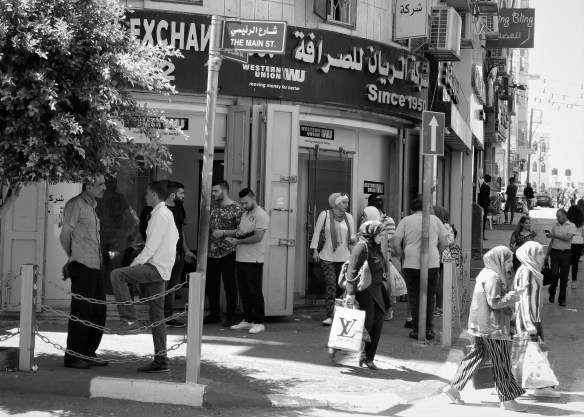If it’s Thursday, it must be Ramallah. Another day, another Arab city… Not that there’s anything wrong with Arab cities.
So, I went to Ramallah, the de facto capital, political, economic, and cultural heart of Palestine; religiously relaxed, bars with beer flowing freely and… the epicentre of Palestinian feminist activity. Of course you wouldn’t know all of this popping in quickly for the day as I did. Arriving in downtown, the first impression of Ramallah is that it’s a dirty, congested dump with wall-to-wall hijabs and no scent of any alcohol anywhere. Quick disclaimer: Obviously there are huge extenuating circumstances. Ramallah is a city that you need to spend either a couple of hours or a couple of months in. It’s the kind of place where you need spend time and really get under the skin of the city and you would be rewarded. Otherwise, it’s not a pretty place so just do your business and get out.
The trip to Ramallah, like the other West Bank cities, starts at the bus station at the Damascus Gate; Bus 218 or 219. Again, as with going anywhere in the West Bank, it requires going through military checkpoints. For Ramallah, you go through checkpoint Qalandia, just on the border of the two cities. While the other checkpoints obviously, are not great, they didn’t seem too bad. Qalandia, on the other hand, is a bleak and depressing place with a very cold war-like feel to it. Although the distance between the two city centres is only 16 kms, with all the traffic and checkpoints, it ends up taking a very long time.
Once you pass through the checkpoint, you’re on Ramallah Road, a long road that snakes all the way to the centre. Think Parramatta Road in peak hour, but in Ramallah it’s peak hour all the time. Then eventually you arrive at the centre of Ramallah, which is just a traffic roundabout with six rubbish-strewn roads feeding into it! And yes… It’s as bad as it sounds!
Just in case you’re not sure which is the main street of Ramallah…

Some random street scenes…
My reason for visiting Ramallah was to visit the Yasser Arafat Museum. Unlike my impression of downtown, the museum didn’t disappoint. It was amazing! The museum is on three floors and gives and incredibly comprehensive account of Yasser’s life, the Fatah movement and the whole Arab-Israeli conflict. In other part of the museum, are the rooms where he spent the last years of his life while under siege. Next to the museum is his tomb, made of Jerusalem stone.
Once I was finished at the museum, I wasn’t keen to stick around, so it was back on the 218 bound for the Damascus Gate.
Going back to Jerusalem required going through Qalandia again. On the way in, the military don’t check anything but on the way back, it’s a very thorough check. I don’t understand how the system works. At the checkpoint on the way back Jerusalem from Bethlehem, the Palestinians had to get off bus whereas the tourists could stay on. To my surprise, the opposite was the case at Qalandia. I was beginning to feel like a special little butterfly everywhere I went, but this time the two soldiers got on the bus, checked all the Palestinians and told me to get off and walk through the metal detector to the other side. And the bus didn’t even wait for me!! The guy who checked me at the gate was a vile Nazi pig. The metal detector was going off but I was just waiting for him to wish me well and wave me through. This one was gesturing and calling out to me… Of course I couldn’t hear him through all the bullet-proof glass, plus I’m a bit slow on the uptake… He wanted me to take off my belt, my shoes etc… Meanwhile, I’m just jumping backwards and forwards through the metal detector, still waiting for the smile and “Have a nice day”. Finally I removed my shoes and belt and emptied my pockets, and got through the metal detector without it buzzing. He studied my visa for about ten minutes. I think he was new on the job. Then I waited for another bus and made my way back to Jerusalem. It was bad enough going through it one time, but for many people, this is their daily life.






















